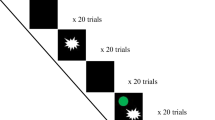Abstract.
We investigated the extent to which humans can quickly adapt their goal-directed arm movements to perturbed feedback. We predicted that the magnitude of adaptation to a changed relationship between vision and kinesthesia would depend on the type of perturbation, being largest when the perturbation can be generalized within egocentric frames of reference. To test this prediction we asked subjects to align a real 5-cm cube so that they could feel, but not see, with a simulation that they saw via a mirror. Subjects made successive movements between target locations in a sequence of adaptation and test phases. During adaptation phases, subjects received continuous visual feedback about the position of the real cube. The feedback was either veridical or perturbed. The perturbations were consistent with either a uniform translation, a scaling or a rotation. The latter two were relative to a central position between all the targets. During test phases, subjects received no visual feedback. We compared test movement endpoints after perturbed feedback with ones after veridical feedback. We found about 40% adaptation to translation, 20% to scaling and 10% to rotation. This difference in magnitude is consistent with the ease with which the transformation can be generalized within egocentric frames of reference. Changing the task so that it required different arm postures did not change the magnitude of adaptation, so postural configuration of the arm does not appear to be critical. Nevertheless, transfer to the unexposed arm was incomplete for translations and rotations, though it was complete for scaling, suggesting that at least part of the adaptation is posture based. We conclude that the adaptation to different kinds of perturbations not only differs in extent but also involves different (egocentric) mechanisms.
Similar content being viewed by others
Author information
Authors and Affiliations
Additional information
Electronic Publication
Rights and permissions
About this article
Cite this article
van den Dobbelsteen, J.J., Brenner, E. & Smeets, J.B. Adaptation of movement endpoints to perturbations of visual feedback. Exp Brain Res 148, 471–481 (2003). https://doi.org/10.1007/s00221-002-1321-4
Received:
Accepted:
Issue Date:
DOI: https://doi.org/10.1007/s00221-002-1321-4




